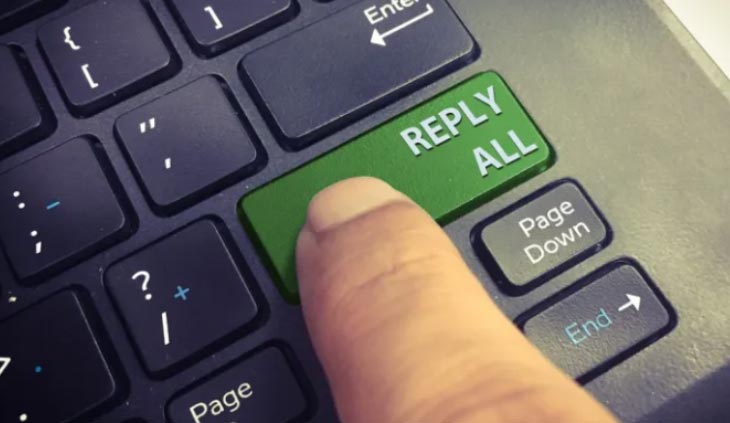
Using REPLY ALL in an email
Using the Reply All button in an email means that your response goes not only to the original sender/author but that it also goes to everyone else that was cc’d (carbon copied) into that email. You can see the recipients of an email by looking in the “To” field and the “cc” field of the email in question.
When should I “reply all”?
Here are some situations in the workplace where reply all is the right way to reply:
1. You have a reply, some information or a response that everyone NEEDS to hear
Use reply all if your question or response will add real value to everyone in the group have a question that other contacts in the thread might have as well. Asking this type of question through reply all lessens the possibility of the original sender issuing multiple replies with the same answer.
2. You need to setup a meeting with the group
Reply all can be a useful way to coordinate a meeting with a small to moderate size group (under 15). If a fellow worker is trying to organise a get together replying with your available time slots can help them corral everyone together.
3. Your reply will have a direct effect on those that receive it
Replying to everyone in the email is a great way to ensure that important information for group in question is received . If your reply will really only concern or affect some of recipients, then consider editing the list of recipients/people in the “To” field so people aren’t unnecessarily inundated.
4. You want to express public praise or congratulations
Reply all can be a great way to publicly praise someone for a win, success, or achievement in the workplace. Consider whether or not you are the 10th person doing this though and whether or not you are just replying all like everyone else. All of these emails can add up to a lot of email “white noise” and potentially come across as disingenuous.
When should i take a different approach than “reply all”?
Tere are instances when reply all is not the right approach. If your email has information that’s unnecessary to some recipients in the original message group, consider a different approach. Here are some email situations that might benefit from a different approach:
1. You only need to reply to a few people in the conversation group
Email or conversation groups in the workplace might contain the contact information for any number of parties including external parties like clients, suppliers or even competitors. Considering who’s in the recipient field and whether or not you are taking a large number of people’s focus away to something they don’t need to be involved in. .
2. Your reply really only concerns the original sender
Maybe your reply is really only relevant to the person who sent the group message. This could be for any number of reasons. If this is case, then don’t reply to the entire email thread's recipient list, then send your email only to the original sender.
3. The email sender has asked for acknowledgement and understand of what they have sent out
It’s very common for supervisors, managers, or leaders to send out important or information and ask recipients to read and reply with the words to the effect of “read and understood.” This is a great way to share information and make sure that those in the workforce are recorded as having read it and conceiving its importance. In this instance, especially where there are many recipients, everyone does not generally need to get 10, 20 or even more emails in their inbox that say; “read and understood.” Consider sending this reply to just the original sender.
Alternatives to the Reply All function in emails
Remember the basic alternatives to Reply All that can make life easier and avoid filling everyone’s email box up and ensuring that the right people get the information you are trying to transmit. These include:
1. Go face to face or vocal
If it’s a quick and relatively minor piece of information to transmit, consider walking into someone’s office if that’s a possibility. That may get you both on the same page easily and quickly.
2. Forward
When you send an email or reply to someone you can actually forward it to the original sender and add others in the “To” or “cc” field. sends the message to a contact not included in the original “To” field. This allows you to create a custom group of recipients.
3. Cc
Email carbon copy (or “cc”) is an easy or effective tool to keep people across what you are saying in your reply. Consider adding or deleting those recipients in the cc field so the right people get the right information. The cc field is a way to ensure recipients needs are informed and across the subject but don’t necessarily have to contribute back.
4. Bcc
Blind carbon copy (or “Bcc”), emails are useful method of keeping someone across the information in question, but other recipients do not know that person has been placed into said communication. The Bcc function is also a great option for sending an email to a group who do not need to correspond with each other.
